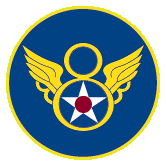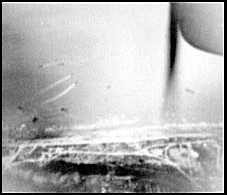 THE 20TH.FIGHTER GROUP
THE 20TH.FIGHTER GROUP
AND THE INVASION OF NORMANDY
While the facts, statistics and strategies have been covered an endless amount of times in books, movies and on the net there seems to be little mention of what was going in the skies above the action on the beachs. This is where the 20th. Fighter Group played their part in the turning point of this great conflict. |
 An aerial view of the Normandy beach head. (Photo courtesy of the USAF Museum)  Capt. Ilfrey prepares for his first mission in the darkness on the morning of D-Day. (Photo courtesy of Maj. Jack M. Ilfrey) |
| The aircraft and pilots of the 20th.FG were grounded June 3rd. and groundcrews began painting invasion stripes on the aircraft in preparation for the coming action. On the night of June 4th. the pilots practiced night formation flying, landings and takeoffs. Capt. Art Heiden recalled, "Though spring Days are very long in England, rain and clouds shortened them.
Consequently, more darkness than was probably planned. There were many difficulties flying
formation on the glow of the turbochargers, which became increasingly more difficult in the
clouds and rain. No navagational lights were allowed, or wanted. "The English runway lighting system initially caused some concern, but worked out well after getting used to it. The very dim lights were guarded so you could not see them until lined up on final approach. Requiring D/F Steers until perfectly lined up less than a mile out." On June 5th. an armada of Allied vessels began to depart from England for the Normandy coast en masse, carrying the largest invasion force in history. The 20th.FG's job was to provide cover for these convoys as they made their way across the English Channel. The Fighter Groups flying P-38s were chosen because of the aircrafts' ease in recognition and the familiar silhouette of the 20th.'s Lightnings began filling the sky at aprox. 5 pm. "German intruders would follow bombers home in the night, get in the pattern with them and shoot them down. We were concerned they would do that to us too."Heiden continued, "Our bases were on high alert for infiltration and airborne attacks. We had those little British armored cars, wore our 45's, and Concertina wire around the airfield. These were two big 6' coils, laid side-by-side with another coil on top. I came back one rainy dark night on single engine, hydroplaned off the runway, chewed through the Concertina into a muddy field. A CleTrack pulled the aircraft out. Max filed the notches out of the props and replaced the Carb diaphragm and I was in the AM line up. Our runways were like 3500' long. Two or three missions a day wore you out in a hurry, especially the night part of it which was probably to integrate the limited number of night fighters available. We were useless at night. I can recall being alerted that unidentified aircraft were in our location at least once." As the morning of D-Day arrived the men were awakened early and their first patrols began in the darkness at 3:46am. Each squadron was dispatched three times throughout the day and each mission lasted aprox. 90 minutes. With the skies nearly empty of all but Allied aircraft there was little excitement save for that of Maj. George Wemyss, who undershot the airfield in the darkness and destroyed his P-38. He walked away virtually unscathed.
" It was a sight I shall never forget - four thousand boats merged into one, big, spectacular prong, ready to lash itself on the enemy coast, thousands of men lying flat on their stomachs in the boats and hundreds of airplanes patrolling the sixty-mile stretch from the English coast to Normandy." wrote Jack Ilfrey in his autobiography Happy Jack's Go Buggy Click to hear Jack Ilfrey talk about his view of D-Day.
The patrols continued through June 9th., when bad weather kept the 20th. on the ground, and ended on June 10th. The pent-up anxiety of having prepared for combat with large numbers of enemy aircraft was somewhat relieved on the last day of these patrols when Col. Harold Rau's patrol turned inland near Granville and made straffing runs on targets of opportunity. This netted a large number of enemy trucks and transports. Col. Cy Wilson alone destroyed eight ammunition trucks.
For an in-depth look at the Invasion of Normandy we suggest the following websites: The Encyclopedia Brittanica's Normandy 1944 The National D-Day Memorial Foundation D-Day Web: The Real Normandy A P.B.S. Show on D-Day Trivia Fact: The D in D-Day actually stood for Day. |
RETURN TO SELECTED MISSIONS OF THE 20TH.FG
Unless otherwise noted, all content © copyright The Art of Syd Edwards 1998-1999. All rights reserved and reproduction is prohibited.

